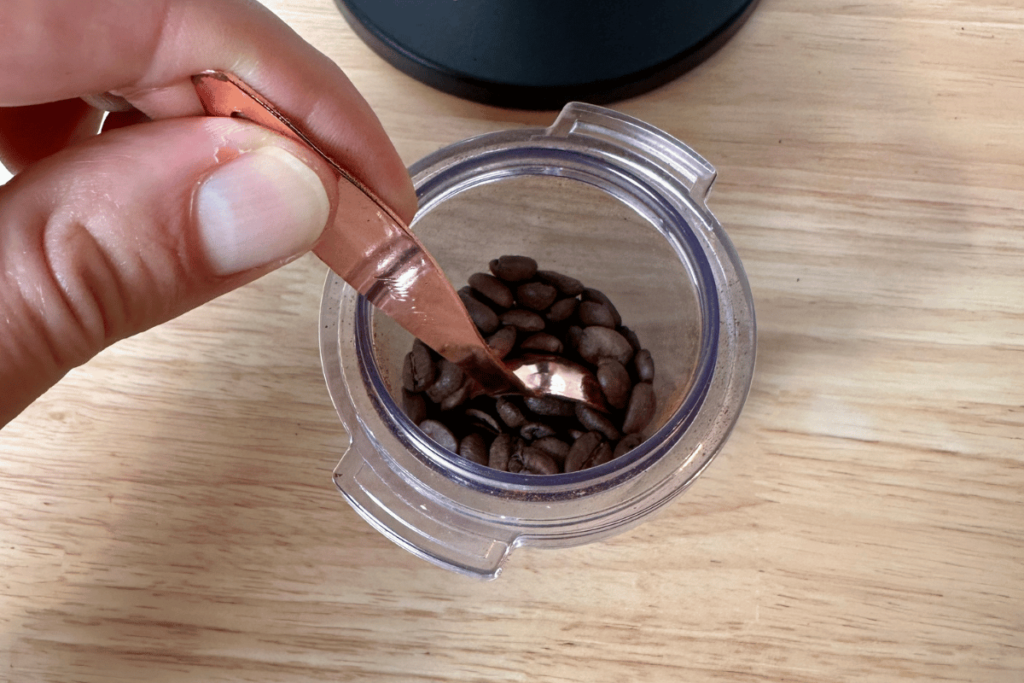You’ve finished grinding your coffee, and you’re anticipating the delicious flavor of java in your mouth. You remove the grounds container, and it happens: flying coffee particles are on your hands and cup, stuck to the sides of the chamber, and they make a mess on your counter. This happens because of static electricity.
Different coffee grinders produce more or less static, which means more or less mess for you. Luckily, there are a few tricks you can use to lower static electricity when grinding coffee beans.
I’ll explain all the reasons static in the coffee grinder happens and the best ways to deal with it so you lose a minimal amount of coffee grounds.
Causes of Static In Coffee Grinders

To understand why static happens in your coffee grinder, we have to talk about physics. Everything in the world is made up of atoms. Static happens because of a positive and a negative charge in an object. Each atom has:
- Protons — Have a positive charge
- Electrons — Have a negative charge
- Neutrons — Neutral; don’t have a charge
If an object has a positive and a negative charge, they are balanced out. But, if there’s an imbalance, the result is static. Static builds on a surface of an object until it’s discharged. Once electrons are released, there’s static.
Here’s how this relates to your coffee grinder: the contact between your coffee beans and the grinder beans creates friction. Friction causes the beans to pick up an electric charge. Electrons are moved from one atom to another, which creates an imbalance between the grinder and the coffee grounds that leads to static.
The imbalance causes the coffee dust to come out of the grinder and make a mess. The grounds are trying to move away from the grinder (because it has the same electrical charge).
The most common factors that cause static buildup in a coffee grinder:
- Low humidity (most common, as static builds up easily in dry places)
- Dry beans (as this is similar to low humidity)
- Old beans (these tend to be dry)
- Certain grinders* (more plastic components).
*Although to be fair, static is a common issue across grinders in general, so chances are it’s not your device.
How to Reduce Static in Coffee Grinder
There are several ways you can reduce static in your coffee grinder.
1. Ross Droplet Technique
The Ross Droplet Technique is named after David Ross, who came up with this hack in 2005. The trick is to add a few drops of water to the coffee beans before grinding. The water droplets add humidity to the grinder and reduces static.
Here’s what to do:
- Weigh out your coffee beans
- Fill a spray bottle with water
- Spray the coffee beans
- Shake the beans so the water is evenly distributed.
- Put the coffee beans in the hopper and grind
There are some variations to this technique. For example, you can wet a paper towel and drop a couple of drops of water around the grinder hopper.
Or, you can try James Hoffmann’s variation of the RDT:

- Weigh the beans
- Grab a teaspoon
- Quickly run the handle under running water
- Stir the handle into the beans and grind
If you’re nervous about adding water to your grinder, especially an electric one, remember the key is to keep the amount of water small. You don’t want to soak the beans in water.
Also, here are a few precautions to keep in mind:
- RDT works with single-dose grinding.
- Humidity affects the freshness of the beans. Once you add water, the natural compounds that provide flavors start to break down, so you should use this technique right before grinding. Also, you should use all the beans in one sitting.
- Only use a tiny amount of water and make sure the droplets are evenly distributed among the coffee beans.
2. Wait
If you don’t feel alive before your morning caffeine kick, this trick may be difficult for you, but it’s an effective one. Essentially, you should sit back and wait a few minutes after grinding, which eliminates most static electricity.
Wait five minutes for medium-grind coffee (for example, if you’re grinding for a regular drip coffee maker). After five minutes, tap the ground coffee chamber before you open the lid. This sends coffee grounds to the bottom of the container. If you have finer grounds, for example, for an espresso, wait for a few extra minutes. If you have coarser grounds, for example, for a French Press, wait less.
3. Grind Into a Metal Container
The final thing you can do to get rid of the coffee grinder static is to grind into a metal container (including your portafilter). Metal is a conductor, and electrons can flow between molecules. Electric charges are in harmony, which can reduce static electricity.
However, most coffee grinders use plastic components, and plastic is an insulator. Plastic causes static to buildup, which results in a release of coffee dust particles in the air. The same goes for rubber and glass. These materials don’t allow electrons to flow easily to other atoms, so there’s more static cling.
One simple metal container is your portafilter: where dosing right into the filter basket should reduce static.
Coffee Grinder Static: Final Thoughts
The key to lowering static in coffee grinders is water. You can use a mist spray bottle, a wet paper towel, or a teaspoon handle to add a few drops to the coffee beans. Make sure not to overdo it, as only a few drops are enough. Plus, you should do this immediately before grinding for the best flavor.
Want to learn about other common coffee grinder issues to get the most out of your grinder? Here’s everything you should know about grind retention, including what it is and how to fix it.




